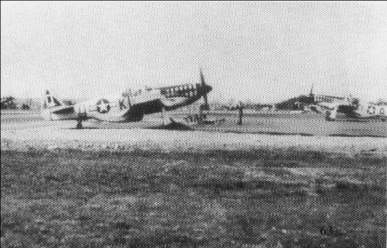The 20th. FG was comprised of three squadrons:
(Click on the squadron number to view a roster of their pilots and P-51s.)
- The 77th. FS (Callsign:"Rebuke" until April, 1944, then "Outcry" -A Group- and "Glory" -BGroup-)
(Black circle on tail with white last letter of squadron code, Squadron codes beginning with LC-)
- The 79th.FS (Callsign: "Crownright" until April, 1944, then "Primrose" -A Group- and "Screwgun" - B Group-)
(Black square on tail with the last letter of the squadron code in white, squadron codes beginning with MC-.)
Until the summer of 1944 the group was equiped with the twin-tailed Lockheed P-38 Lightning, originally painted in the standard olive drab over neutral gray scheme of the USAAF. When the AAF opted to leave their aircraft bare, the later model aircraft of the 20th. arrived in natural (unpainted) aluminum with only a few distinguishing marks. The 20th.FG P-38s (as in Capt. Heiden's P-38, portrayed in the stamp shown above,) wore yellow on both spinners and the fronts of their engine nacelles and a white band on the nose just behind the gun ports. The group flew P-38H and J models from December, 1943 to 21 July, 1944. There were also a few P-38L models that made their way to the 20th prior to the Group's transition to the North American P-51 Mustang.

55th.FS P-51s warmup prior to take off on another mission. Note the "piano keys" or "zebra stripes" on the engine cowling. The spinners on these aircraft are completely black, denoting that they are from the training section of the 20th.FG.
The 20th. FG transitioned to the North American P-51C and D Mustang on 21 July,1944. These aircraft were delivered natural (unpainted) aluminum with the first third of the spinner painted white, from there to just before the exhaust stacks, the aircraft were painted black, this followed by a white stripe (see Bradshaw photo below.)
After August-September of 1944, the 20th.'s Mustangs were adorned with what was affectionately known as "Piano Keys" or "Zebra Stripes" on their noses for their Quick Identification Markings. This was a series of seven black and six white vertical bands, each six inches wide, that ran from the anti-glare panel to just below the exhaust stacks. Nose art was generally applied below this band and usually consisted of little more than the aircraft's name. Many of the 20th.'s P-51s were painted olive drab on the tops of the fuselage, wings and tail surfaces, this feathered downward in an illregular manor to aprox. the top of the national insignia and aircraft's ID letter. The flight commanders' aircraft also bore black ETO bands on the tops and bottoms of the wings, vertical and horizontal tail surfaces. The first third of the spinner was painted white with the remainder being black, except for aircraft used for training which had all black spinners(see photo above). There are pictures of many with the national insignia's white areas "grayed out", though these seems to have been individual choice or the result of exhaust staining, and not necessarily regulation. In many cases serial numbers on the Mustangs' vertical tails were painted over by the squadron's identification symbol (triangle, circle or square,)but again there seems to be no clear-cut rules on this. In December of 1944 the group received their first P-51K models, which externally were little different from the D models. It should also be noted that many sources state the last letter of the squadron codes corresponded to the first letter of the assigned pilot's last name (example: MC-I was a 79th.FS P-51 flown by Jack Ilfrey.) In cases where the squadron contained more than one pilot whose last name began with the same letter a bar was added beneath the letter on both the tail and the fuselage.(As visible in the photograph above, nearest P-51.)

Capt. James "Brad" Bradshaw and his crew in front of "Jeanie." Note the olive drab paint applied to the top surfaces of the aircraft and the D-Day Invasion stripes on the landing gear door. This picture was taken 5 August, 1944, prior to the addition of the "piano keys"/"zebra stripes". Bradshaw completed over 300 hours in combat and received two Distinguished Flying Crosses , three air medals. and a Distinguished Unit Citation.